Continued from Part 2
Part 1 | Part 2 | Part 3 | Part 4 | Part 5
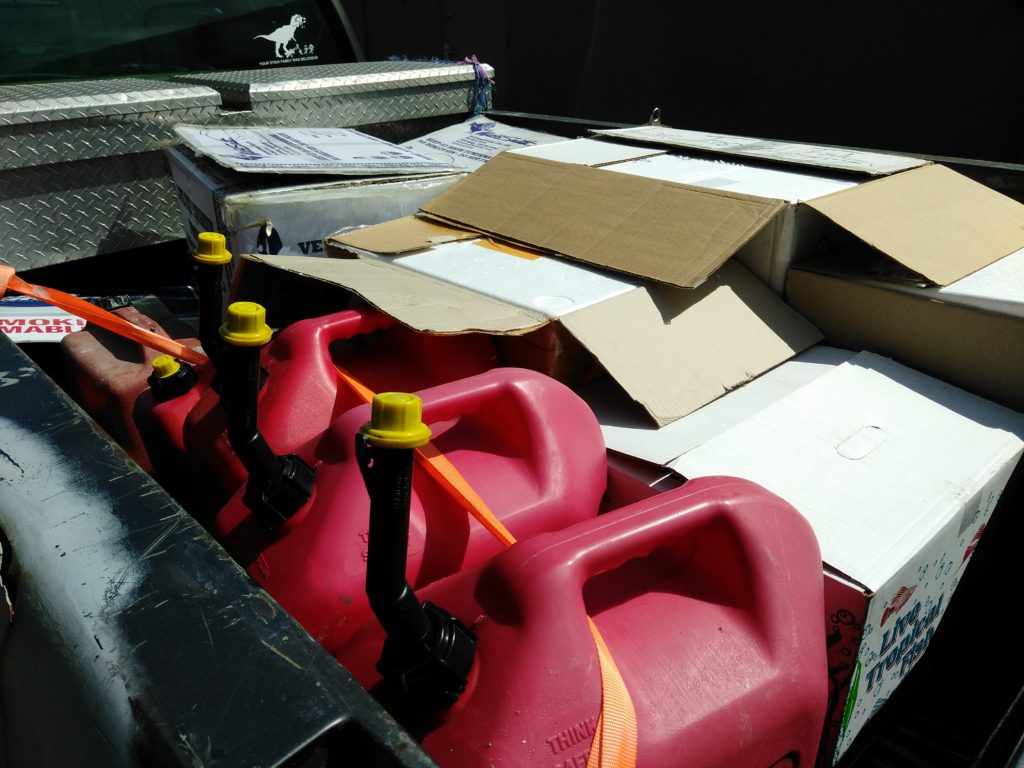
Fuel, arguably one of the most talked-about commodities for aquarium businesses facing multi-day power loss. Coral Sea Aquariums stocked up; learn more about their story below. Image Credit, Coral Sea Aquariums
Friends in Florida, continued
Marco Rocks
Homestead, FL
www.MarcoRocks.com
Status: Marc Tetreault, founding partner of Marco Rocks, shared an update via Facebook around noon on Tuesday: “Great news coming in right now. MR survived! We are flooded and quite a mess, but our main work areas which are built up 3′ are okay, all equipment that had to stay out runs, office stayed dry, storage container stayed dry, green house frame is intact…and…one of the kittens spotted already under the shelter we made them. Very Happy right now!!!!! It’s a mess for sure but everyone stayed safe and equipment losses are at a bare minimum. As soon as UPS and trucking resume MarcoRocks will be shipping again. Hoping all our FL friends get the same type of news as you return.”
Later, Tetreault remarked while chatting about the clean-up ahead that “One thing you don’t see on TV is the heat and mosquitoes.”
By Thursday, Tetreault was notably relieved, having made it to Homestead. “It’s a huge cleanup effort. The city is pretty beat-up. There’s huge damage to the electrical infrastructure; there’s poles and wires down everywhere and lots of flooding and very few stores open. But despite all that, today, Thursday one week after we evacuated, we are resuming shipping UPS orders, and tomorrow (Friday), eight days after evacuation, we are resuming shipping truck orders.”
How They Did It: Simply put, the team at Marco Rocks “buttoned up the business as best they could” before evacuating.
Image Credits: Marco Rocks
Nautilus Wholesale
Plant City, FL
www.NautilusMarineWholesale.com
Status: Nautilus customers received an email update on Tuesday with good news. “We are all safe and back in the office. The farm sustained very minor damages and we will be able to ship fish out via FedEx starting tomorrow (Wednesday 9/13). If you usually pick up your fish at the airport, we are hoping regular airline shipments will resume toward the end of the week. If you have any questions, would like to place an order, or even give your rep a verbal phone hug, feel free to give us a call!”
Following up on Wednesday, Joe Hiduke, Sales Manager, took time out of his hectic day to send more details. “We were very, very lucky with Irma. We miraculously had very little damage. We lost plastic over some of the buildings and had a lot of standing water. We didn’t lose power at all, and I have no explanation for that. I was watching the path very closely, and expected to see a disaster when I got back to work. I feel very fortunate to report that was not the case at all. I haven’t heard from some farms, but I know others were hit a lot harder than we were.”
On Hurricane Preparedness: Hiduke shared a quick overview of what happens when a storm is imminent. “Our standard hurricane preparation includes pumping down the ponds and making sure the generators are all functioning. While we haven’t had a major storm pass through in a long time, the farm has been here for decades, so our policies are pretty well set. There’s not a whole lot more we can do beyond hoping it’s not a direct hit on the farm.”
Image Credits: Nautilus Wholesale
Joe Mason – Avid Aquarist and Founder of the Florida Fancy Guppy Club
Vero Beach, FL
Status: “We were without power for three full days. We took heavy losses with my catfish fry. The guppies, on the other hand, did well without incident.”
Advice: “Do water changes before storm arrival and thin populations in tanks that have dense populations. Once you lose power it will get very warm and the oxygen level will be lowered. I lost hundreds of Ancistrus fry and Corys; all else managed OK. The heat we are dealing with is very damaging to most catfish, so if you have the opportunity to do massive and daily water changes they will do better. Clean water and high oxygen levels make a huge difference. Also, if you are going to put supplies in coolers to preserve, utilize frozen blocks rather the ice cubes. Cubes will last about a day and a half at best; blocks will last for days. Currently the cooler I have with block ice is on its fifth day and the ice blocks are only half melted.”
AlgaGen
Vero Beach, FL
Status: We received a succinct update: “AlgaGen is bruised, but back fully operational next Monday. No downed trees being this close to the coast, and we lost most of the trees we did have last year to Hurricane Matthew.”
On Dealing with the Aftermath: “Copepods and phytoplankton are pretty resilient. Copepods slow down reproduction rates due to lack of food but will bounce back quickly. Cooler temp phytoplankton like Rhodamonas will certainly take a hit. However, we are prepared for this and have several backup cultures in various stages of resting/stasis that we can activate and bring up to speed.”
Chemipure [Boyd Enterprises], Reef Aquaria Design, and Jellyfish Art
Coconut Creek, FL
Boyd–Enterprises.com
JellyfishArt.com
ReefAquariaDesign.com
Status: Wednesday evening, 9/13, we received a detailed update from president Jeff Turner. “All is good with our three companies, Chemipure, Reef Aquaria Design, and Jellyfish Art. Our entire crews all stayed safe during and after Irma, and most of us were back to having fun in the aquarium business today (however, it really is work!). Several of our crew are still without electricity and either on generators or staying with friends with power. I’ve been running generators at home since Sunday and we’ve worked at cleanup here in the yard and house and warehouses. We heavily prepare for annual hurricane timeframes and have regular meetings to discuss and plan out our before, during, and after plans. First and foremost is everyone’s safety, and many of our team members did, in fact, leave town.
“Our jellyfish team did an amazing job at keeping power to our systems via generators and flow pumps and temp control; we shipped live jellyfish today via FedEx to customers with pending orders outside of affected hurricane areas.
“Chemipure prepared all current orders of product shipments today, and the freight companies are scheduled to start picking up pallets tomorrow. We do have significant inventories of Chemipure products at all times.
“Our aquarium services division at Reef Aquaria Design surveyed all of our clients’ aquariums in the past two days and found all in very good condition, either with power or back-up generators. However, several were operating only on battery back-up EcoTech or simple Penn Plax Double D blue air pumps that run for at least 24-36 hours after the power shuts off. Those little blue air pumps are excellent and keep hundreds of beautiful healthy fish and coral alive in very significant reef aquarium and jellyfish displays under our care!!!
“The company vessel made it through the storm on Miami Beach tied up on its lift way high with many lines, bumpers, and fenders and the bow and stern anchors tied off to pilings and docks. Today I prepped the boat for travel tomorrow by ocean to the Keys, as the roads going in are closed. We will assess our aquarium accounts in that area and also assist with any needs that other aquarium companies may have down there. It’s pretty much a big mess down in the Keys, and we will do our best to help our neighbors in the fish business, and folks that simply are in need. It will be a very interesting boat ride to the Keys tomorrow; I guess it will come to 165 miles-plus, traveling southbound against the Gulfstream around the northern Keys, as I plan to stay in deep water only to avoid any reefs and tons of floating debris that could place our vessel and crew in harm’s way. We will try to stop in at the Coral Restoration Foundation’s Tavernier coral nursery on the way back to assess how the hundreds of coral trees fared in the surge.
“It’s a tough several months ahead for folks in the Keys, and we will do our best to help our neighbors here in the great state of Florida! Sunshine and calm seas tomorrow. It will be the most interesting boat ride to the Keys ever for me…”
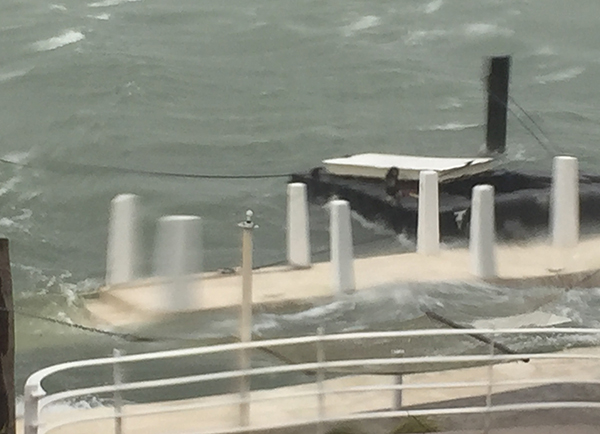
The Turner family dock going under during Hurricane Irma. Image; Jeff Turner.
Coral Morphologic
Miami, FL
CoralMorphologic.com
Status: Coral Morphologic managed to stay connected through most of Irma, sharing two updates on Monday, September 11th. “The Coral Morphologic team is safe, with 1/3 of our corals in a powered location. Currently assessing damage to our lab, updates soon…” Later that evening, things were sounding upbeat. “Update: The Coral Morph team is safe, all corals and creatures accounted for a d healthy. Feeling very lucky – we fully prepared for an eye wall hit and were spared that level of damage. Our thoughts and prayers go out to everyone and everything in Irma’s path.”
In the calm after the storm, not everything was as it initially appeared. Colin Foord, co-founder of Coral Morphologic, shared his personal tale Wednesday evening. “I guess I spoke too soon when I said we had zero coral mortality during the hurricane…but then again they say that the biggest dangers come after the storm has passed and you let your guard down.
“So after the storm had passed on Monday morning, I was able to get the generator running at the house I was tank-sitting at on Miami Beach. Hurrah! I had brought about 1/3 of our coral collection, including the oldest/most sentimentally valuable to us. My friend has a custom 600-gallon Italian Elos aquarium inside his house, and a 200-gallon Elos in the garage as a quarantine system. Each system is pretty much running entirely automatically with all the bells and whistles (the owner is sort of hands-off with the day-to-day of his tanks).
“So anyway, once we had power again Monday morning, I checked on the Apex controller on the quarantine system and it was reading the correct time and date. Good, that must mean that all its programming was saved, and is thus okay for me to leave running while I headed back to the mainland for the first time to assess the damage at CM (Coral Morphologic) HQ and get our generator running. But since Miami Beach was closed for re-entry until Tuesday at noon, I wasn’t going to be able to return for 24 hours.
“No worries. I had a friend staying with me there who was also keeping several dozen ultra flower anemones in the same system, and I guess I naively presumed that he’d check in on the status of the system while I was away, since he was relying on selling them post-storm to get back on his feet financially. I should not presume. I should not presume. I should give explicit orders so that there can be no confusion of responsibilities.
“Anyway, I return home to find the house is structurally intact and all the corals alive. Spent Monday night at CM HQ while cleaning up the inside and outside of the house. When Miami Beach finally opened to everyone on Tuesday afternoon, I headed back over to get the cat and my pet toads. Again, foolishly, I did not pop my head into the garage to just check on the status of the quarantine system, and instead went directly into the main house to get my pets. I returned home again, dropped off the pets, and turned around to start bringing more stuff back to the house (we literally packed up everything that was important to us and brought it up the second floor of this mansion, just to be sure it wouldn’t get flooded). Before the hurricane, we had already prepared to lose everything at CM HQ if a tree fell on the lab or office. Basically, we packed up like we might never be able to return.
“So I return to Miami Beach for the second time yesterday in the afternoon, and the first thing I do is check in on the corals. You cannot imagine the feeling I felt in my gut when I saw that the tank was dripping in condensation and I looked down at the chiller thermostat and it is reading 58.5F. F********K. The water was still clear and the corals weren’t sliming. The couple of fish that were already in there were swimming around. A somewhat good sign. We proceeded to do a bucket brigade using water from Biscayne Bay itself (not recommended, especially at low tide after a hurricane, but there was no saltwater ready to do a massive water change, and I felt it was more important to get the temp back up to at least 70F.) After doing more than a 50% water change, we got the temp to stabilize to an acceptable level.
“So what happened? Why does an aquarium chiller designed and sold specifically for reef hobbyists not have a built-in shut-off mechanism if the water gets below, say, 65F? I don’t know if the issue was with the chiller (an Arctica), or the Apex not shutting it down like it should have when it reached its low temp set point. I didn’t set up the system, so I just don’t know it well enough. I presumed it would be safe like it always had been before the hurricane.
“But the snafu definitely points out that relying on full tank automation is no guarantee of success, and in fact can lull you into thinking you don’t have to worry about system parameters because the ghost in the machine will take care of it. The irony is not lost on me that the only corals that we had die as a result of Irma, did so not because they got too hot or oxygen-deprived, but because they got too cold! In Miami. In early September. There is literally a brigade of cops down the street from me right now distributing free ice to people without electricity, and the chiller running off a massive home generator in a $15 million mansion goes right ahead and cold-nukes my babies.
“I didn’t want to immediately remove all the corals from the tank yesterday because the last thing I wanted to do was bring home corals that were going to be dying overnight and start a chain reaction of death to the other corals in our main lab. Definitely don’t want to have to deal with that when I still have everything on generators. I had 500 gallons of saltwater stored before the storm just in case I’d have to do a total water change, but that’s definitely not something you want to do unless it’s an emergency. So I returned this AM and assessed the damage. The water was brown, cloudy, and emanating the unmistakable smell of fresh coral death.
“The upside is that I think that 50-75% of the corals I brought to Miami Beach for the storm will survive. The downside is that I lost my very favorite coral: a really unique free-living colonial Sandalolitha robusta Fungiid from Australia that we’ve had for about five years and that I never properly filmed. Like a dummy. I almost did last week while we were preparing, but it was so big that it required more space than I had available in the studio system. C’est la vie. C’est la mort.
“So, yeah, I am still thankful to be alive. I’m thankful that all my friends and loved ones are doing well. Dropping my iPhone into a puddle on the roof while trying to unclog the roof drain of a totally insured house during the hurricane was a bummer, but it’s comically ironic that after 17 years of cell phone ownership as a coral aquaculturist and diver, I have never killed a phone before or dropped it into the water, and here it happens on a friend’s roof at a house I’m protecting during a hurricane. Not having a phone to be able to reach loved ones is not fun, but hey, when you don’t have any electricity, and there are so many other immediate stresses to deal with, losing a phone isn’t worth complaining about when other people have lost their homes, lives, pets, and loved ones.
“Losing my coral friends hits a bit harder, but again, most of the corals I lost were all high-end clones (my Mycedium chalice coral collection, for instance), which means that I can re-acquire them again in the future. After all, what is death to a clone? But losing that Sandalolitha is a gut punch. I haven’t had the heart to remove it from the quarantine tank. I’ve siphoned off as much of its tissue as I can, and want to believe that perhaps this is a Fungiid that can rise like a phoenix the same way its Fungia cousins can from their ‘dead’ skeletons. I doubt it, but I couldn’t bring myself to drop it in a bucket of bleach and put an end to it. In the meantime, I cross my fingers that the rest of the coral I was able to save will re-acclimate back home and we will sustain no further losses.”
As of Thursday night, 9/14/17, Coral Morphologic remains without power and has been without power since 12:00 PM, 9/9/17. All systems remain running on generator power.
Tips for Fellow Reefers: Foord shared a very handy backup system put together before Irma hit that seems to have performed reasonably well: “Reefers, I can’t recommend enough to have a 12V-capable bait aerator on hand. Before the storm, I got a couple $35 tractor batteries and a $10 cigarette lighter converter at the auto parts store and a $25 aerator at the bait shop. I set them to run as the last thing before leaving the house Friday night. They were all still bubbling after 48 hours. I used another of the same brand aerator on 2 D batteries alone, and they were still working too. A crappy old 2 D battery air pump on the Caribbean biotope died at some point before returning, so not all brands are created equal. I came back just in time to see my Fairy Basslet gasping for oxygen on the bottom and Harlequin Serpent Stars releasing sperm as a last ditch effort to propagate. Got the generator fired up and return pump running just in time to revive him all the way, followed by a 50% water change at 2 am.”
Image Credits: Colin Foord, Coral Morphologic
Riley’s Reef
Jupiter, FL
Rileys-Reef.com
Status: Thursday morning we heard from Ryan Michaels of Riley’s reef. “Hurrican Irma was a first for me and for Riley’s Reef, located in Jupiter, Florida. We built on our preparatory experience from Hurricane Matthew, which did not significantly impact our area with the property damage and destruction of electrical infrastructure that Irma has left in its path.
“Early warnings for this storm were critical to our ability to prepare ourselves and our customers. Many of us watched the hardships brought on by Harvey and took quick action to secure the necessities to keep a reef tank alive through power failure and rising temperatures.
“The most secure aquarists have backup generators and chillers in place; one of our favorites keeps her 425-gallon reef in power through outages with a generator dedicated to the aquarium system.
“Riley’s Reef’s generator doesn’t get much use, but it stands by for situations like this. We spent precious time before the storm ensuring the generator was still in good working condition with a healthy battery and a full fuel tank. Before the storm, we ran airlines from our Coralife SL-65 Super Luft to the separate systems in our shop. We keep a ‘hurricane kit so we do not have to pull from available inventory to install our life-support systems.
“All of our available aerators sold out quickly and we began to scavenge from local bait and tackle shops and big box stores for any battery-powered aerators and all available D Batteries.
“We offered discounts on dry goods like foods and filter media and prepared excess water to help customers prepare with top-off water and water changes. RODI water-filled bags were frozen throughout the week and packed around frozen foods.
“Our service trucks were on the road until mandated curfews to help deliver water, set up auto feeders, and set up up aerators for customers who had evacuated.
“Thankfully our shop maintained power 90% of the time throughout the storm and power was restored by the morning after Irma passed. We were grateful to only return to a few minor roof leaks and damaged ceiling tiles and missing rain gutters, but thankfully no losses in fish or coral throughout the shop.
“Power is still slowly being restored to our homes and the homes of many customers. Many people survived with few or no casualties, but many were not able to adequately prepare or were taken with the fear for their lives and evacuated without making preparations beyond auto feeders. In some cases, the losses have been severe, and we are sad to have to see the loss of so many mature fish and reefs that we have grown to love in our care and service.
“We are ever grateful that none of our customers lost their homes, and in a few weeks we will have cleared the debris from this storm and will be working to rebuild our Riley’s Reef community of aquariums. Many of the aquarists in our area came together to help one another, both before and after the storm. Those who have had power restored have diligently worked to get their surplus resources into the hands of those without.
“Now that we have weathered the storm, the process of rebuilding begins. We are bringing our best to helping all our customers recover or rebuild their reefs and continuing to bring new hobbyists into the hobby with new aquarium installations.”
How We’ll Improve for Next Time: Michaels has identified four key improvements he’ll be making before the next hurricane: “1. Maintain a surplus of battery-driven aerators and D-cell battery value packs for customer purchase. 2. Increase recommendations of Ecotech DC Vectra Pumps, Vortec Powerheads, and their Battery Backups. 3. Upgrade our shop electrical panel to allow direct connection of a generator to the panel. 4. Increase customer outreach during storms to help those who forget to prepare or forego for evacuation.”
Coral Sea Aquariums
West Palm Beach, FL
Status: Brand-new local fish store owner James Wood certainly got more than he bargained for with Hurricane Irma. “We have a lot to say from the perspective of brand-new saltwater aquarium shop owners! I took possession of Coral Sea Aquarium at 1373 N. Military Trail in Palm Beach County, FL, on Sept 1st. After the hurricane, I got to the shop ASAP. We had already lost one system before we got there, but we kept the others going. We blew a generator but got a second one going. We moved into the shop and lived there until Wednesday night. We had no air conditioning or grid power until Wednesday night as well. We are still in it, but things are improving.”
Suggestions and Observations: “Generators, gas, ice, GGD (Generator Guard Dog), clean socks, etc. were very important. Buying anything was a major effort; everyone wants the same stuff and the roads weren’t exactly safe with the lights out. People not in it don’t understand that nothing electric works; you can’t download anything or even call. I owe a debt of thanks to Boy Scouts for life skills from knots to cooking on a camp stove. I’m also grateful to a network of friends that helped troubleshoot problems.”
-
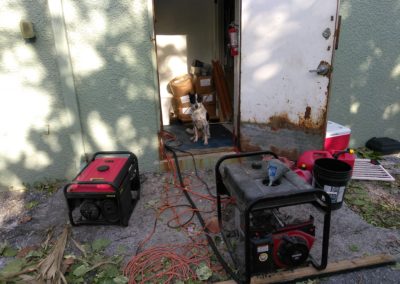
One generator blew, but a second kept things running until power was restored.
-
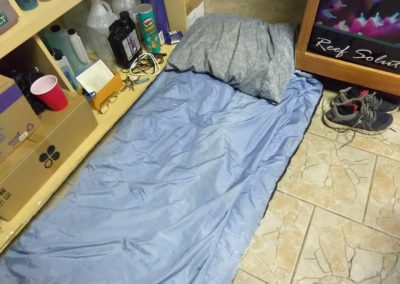
Taking ownership of this aquarium shop involved literally moving in.
-
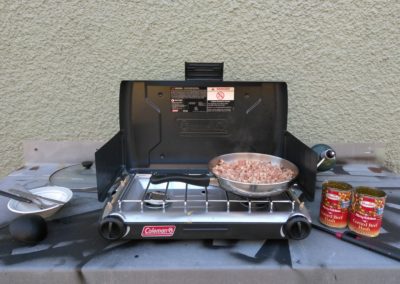
Cooking over a propane camp stove. It'll get the job done, but the novelty wears off after a while.
Image Credits: James Wood, Coral Sea Aquariums


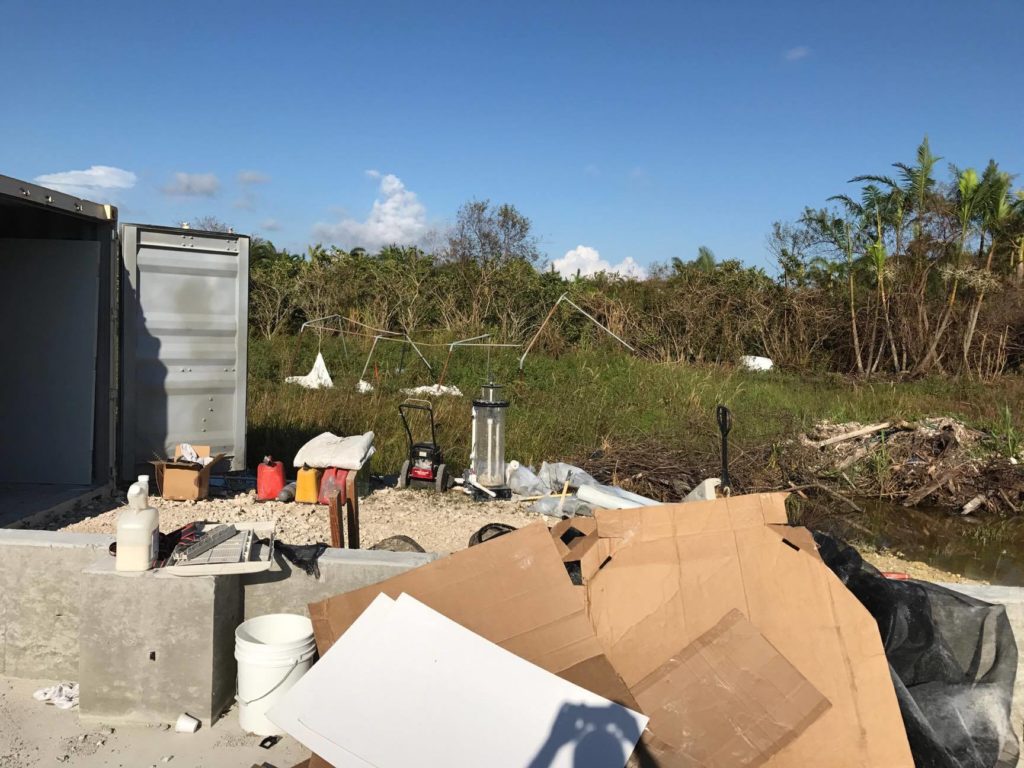
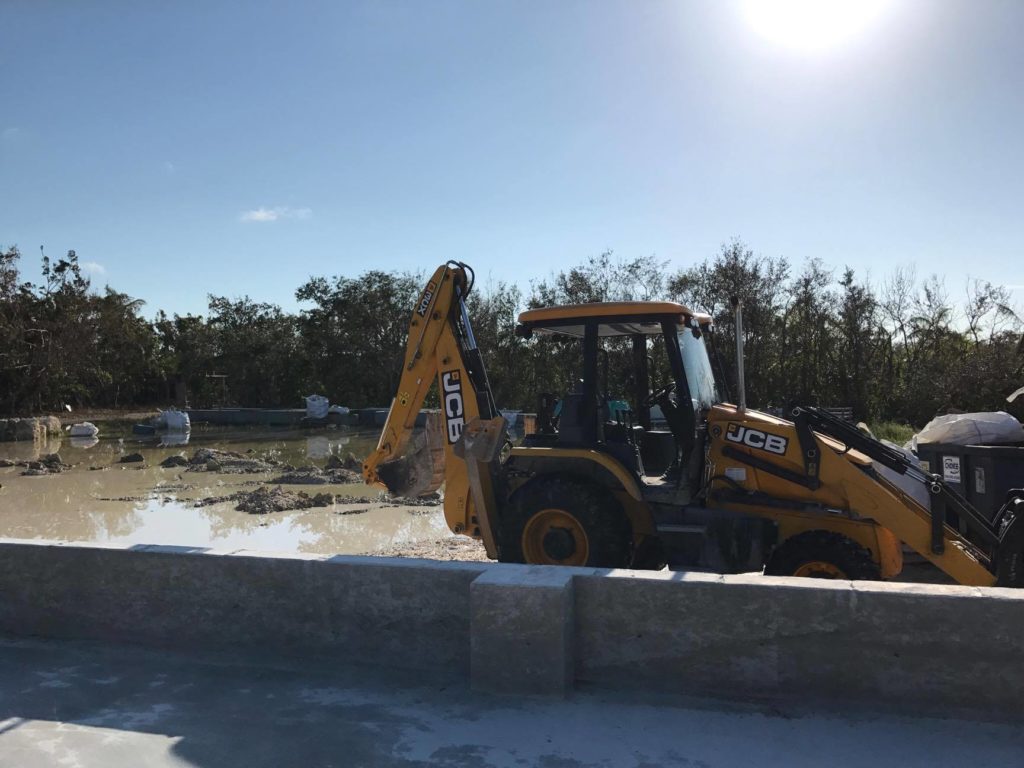
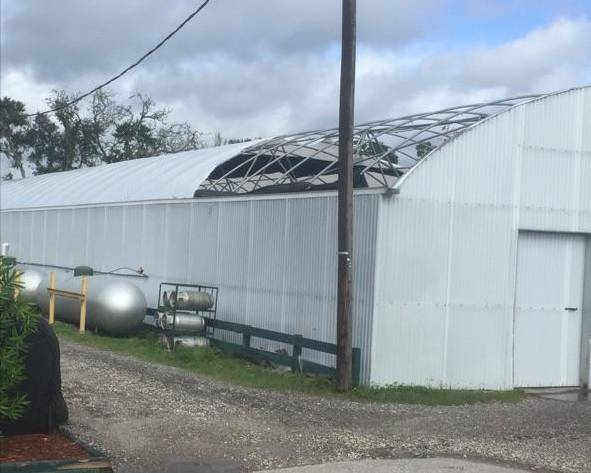
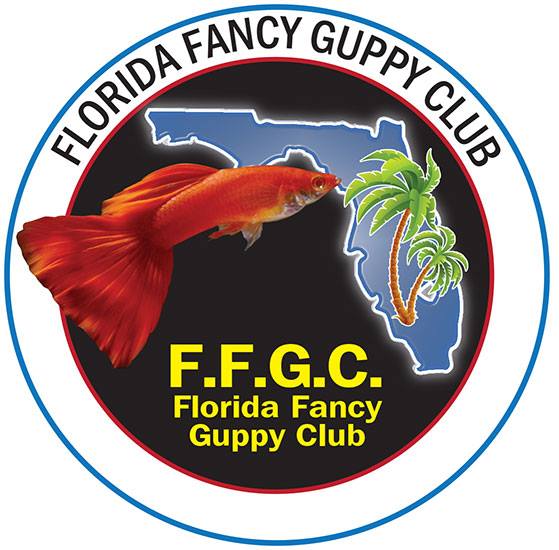
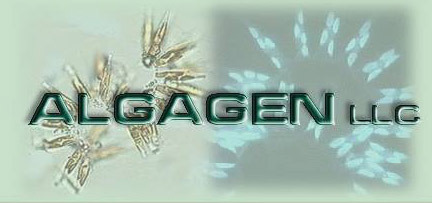


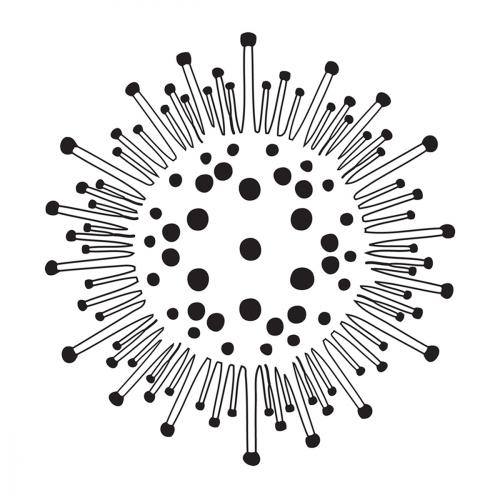
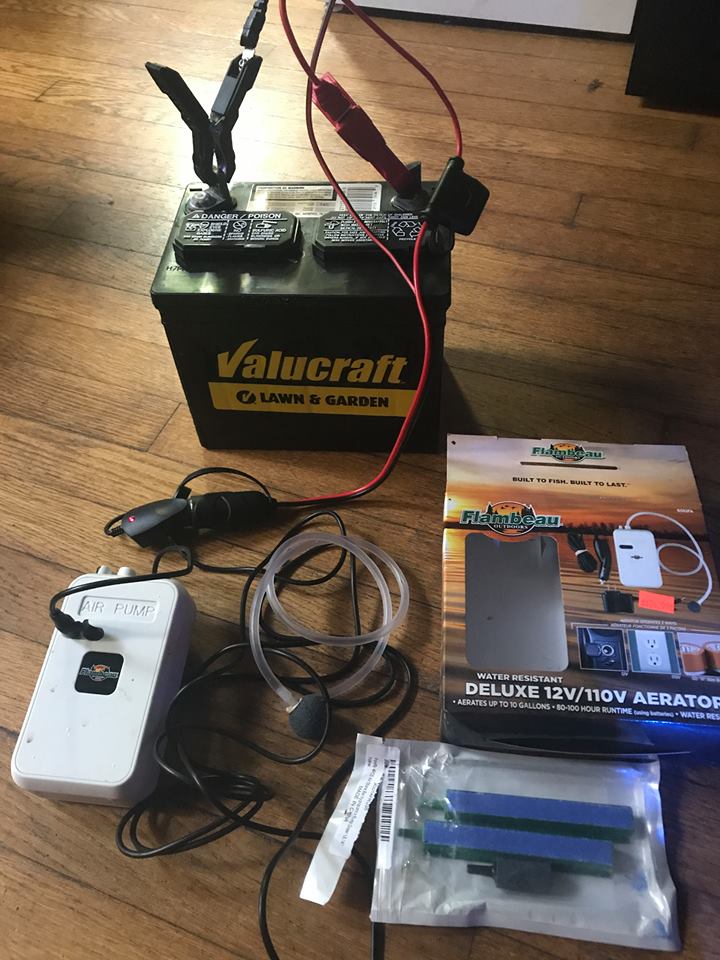
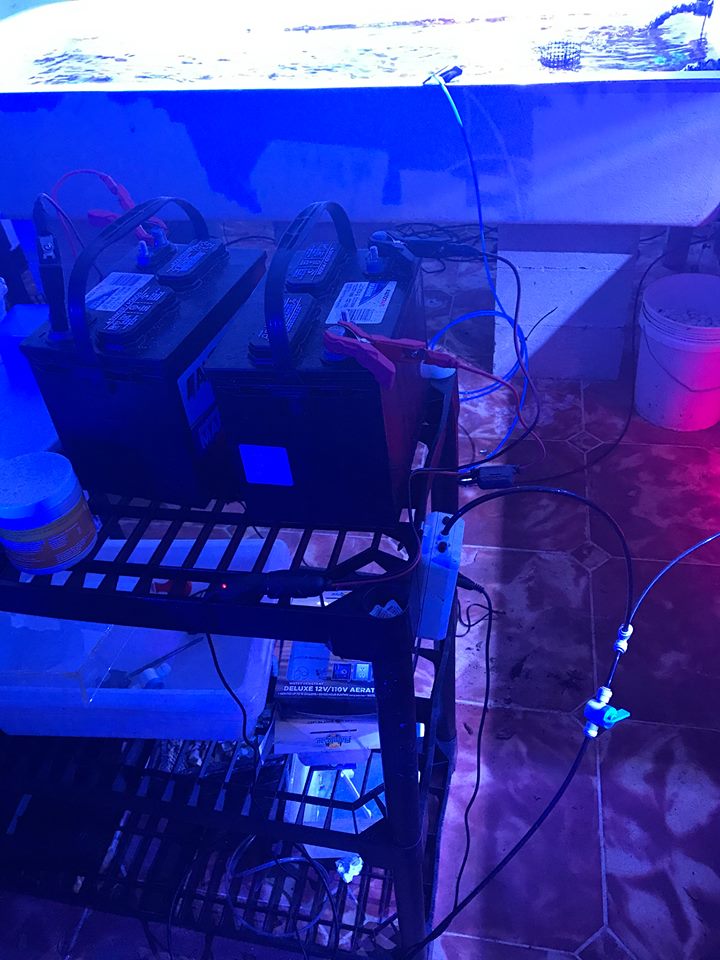
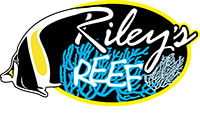





Matt,
Just curious why you always use Nautilus for your freshwater articles and not any other livestock wholesalers. There are many more out there that deserve such free advertising as well. I love the magazine and your articles but try some other recognition.
Thanks,